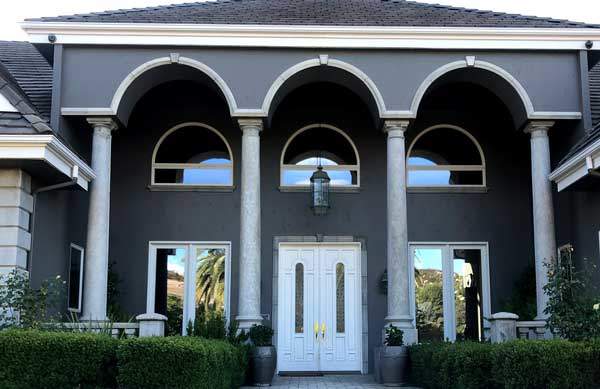Residential Window Tint: Maintain Your Home Comfortable Year-Round
Residential Window Tint: Maintain Your Home Comfortable Year-Round
Blog Article
How Residential Window Tinting Enhances Your Home's Energy Performance
Residential home window tinting presents an engaging remedy for property owners seeking to improve power effectiveness within their home. By using specialized movies to windows, it successfully lowers heat transfer, thus stabilizing indoor temperatures and minimizing the requirement for extreme heating or cooling. This not only stops energy usage but likewise gives a more comfy environment by mitigating glare. Nonetheless, understanding the subtleties of just how tinting works and picking the suitable type for your home can be crucial. Curiously, what aspects should one take into consideration before making this investment?
Comprehending Home Window Tinting
Recognizing window tinting is necessary for home owners looking for to boost both convenience and energy efficiency in their living areas. Residential Window Tint. Window tinting includes the application of a slim movie to the inside or outside surface of glass home windows. This movie can significantly modulate the quantity of sunshine and warm that goes into a home, therefore influencing indoor environment problems
There are numerous sorts of home window tinting films available, each with distinct buildings. For example, colored films absorb solar power, while reflective movies deflect it away from the glass surface area. Ceramic movies use an equilibrium of exposure and heat rejection, making them a popular selection amongst property owners. The effectiveness of home window tinting is typically gauged by its Visible Light Transmission (VLT) percent, which indicates exactly how much light can go through the movie.
Advantages of Power Effectiveness
Window tinting not just improves visual appeals yet likewise plays a considerable role in enhancing energy performance within household areas. By lowering warm transfer through home windows, tinted movies develop a much more stable interior climate, which can bring about significant reductions in power consumption for cooling and heating. This energy effectiveness converts into lower utility costs, providing home owners with substantial long-lasting financial savings.

In addition, home window tinting enhances the convenience of living areas. By minimizing glow and blocking hazardous UV rays, colored home windows create an even more enjoyable environment, which can cause improved health for passengers. The protection versus UV rays likewise aids protect furniture and floor covering from fading, contributing to the long life of family items.
Just How Tinting Works
Tinting movies operate via a mix of advanced products and innovations designed to regulate the quantity of solar energy going into a home. Primarily made up of polyester, these movies commonly incorporate metallic or ceramic particles that show and absorb heat. This double capability enables them to considerably lower the penetration of ultraviolet (UV) rays and infrared radiation while allowing visible light to pass through.
The efficiency of window tinting is gauged by its solar warmth gain coefficient (SHGC), which suggests our website how much solar power is sent through the window. Reduced SHGC worths are more suitable as they represent better heat being rejected. In addition, home window tints can include a selection of shades, enabling house owners to customize their aesthetic preferences while improving power performance.
Additionally, these films function as an obstacle, protecting against heat loss during colder months by showing interior warmth back into the home. This thermal insulation result enhances the air conditioning advantages obtained throughout warmer months, contributing to a balanced indoor environment year-round. By managing solar power effectively, domestic window tinting not only enhances read this comfort but also plays a vital role in reducing energy consumption and lowering utility costs.
Choosing the Right Color

There are numerous kinds of home window films offered, consisting of dyed, metalized, and ceramic. Dyed films are cost-efficient but may have limited sturdiness. Metalized movies use far better warmth being rejected but can interfere with digital signals. Ceramic movies give exceptional warmth control without compromising presence and are highly resilient, making them a popular option.
Noticeable light transmission (VLT) is an additional crucial aspect, as it shows the amount of natural light that can travel through the colored glass. House owners need to select a tint with a VLT that matches their lighting preferences while still giving appropriate glow reduction.
In addition, evaluating the solar heat gain coefficient (SHGC) can aid identify exactly how well a tint can obstruct heat from sunlight. A lower SHGC suggests far better warmth control, ultimately improving energy performance.
Setup and Upkeep Tips
Correct installment and maintenance are vital elements in taking full advantage of the benefits of domestic home window tinting. Specialists likewise make use of specialized techniques and tools, which can boost the longevity and efficiency of the color.
Following installation, upkeep is important to lengthen the life of the window film. It is advised to wait at least 1 month prior to cleaning the tinted home windows to permit the adhesive to cure completely. When cleansing, use a soft fabric and a mild, ammonia-free cleaner to stay clear of damaging the film. Prevent abrasive products that can scratch the surface.
In addition, routine examinations are have a peek here beneficial. Check for any peeling or bubbling, which could indicate inappropriate installment or put on over time - Residential Window Tint. Addressing these issues quickly can avoid additional damages and preserve energy effectiveness. By adhering to these installation and maintenance suggestions, house owners can ensure their window tinting remains to provide significant power cost savings and comfort for years to come.
Conclusion
In verdict, domestic home window tinting offers as a reliable service for boosting power performance within homes. By reducing warmth transfer and obstructing harmful UV rays, home window films contribute to decrease energy usage and boosted indoor comfort.
Home window tinting entails the application of a thin movie to the inside or exterior surface of glass windows. By lowering heat transfer through windows, colored movies develop a more steady indoor environment, which can lead to substantial reductions in energy consumption for home heating and air conditioning.The effectiveness of window tinting is determined by its solar warm gain coefficient (SHGC), which shows just how much solar energy is transmitted with the home window. By taking care of solar power effectively, domestic window tinting not just improves convenience yet also plays an important role in minimizing power intake and decreasing utility bills.
By decreasing warm transfer and obstructing harmful UV rays, window films contribute to lower energy consumption and improved indoor comfort.
Report this page